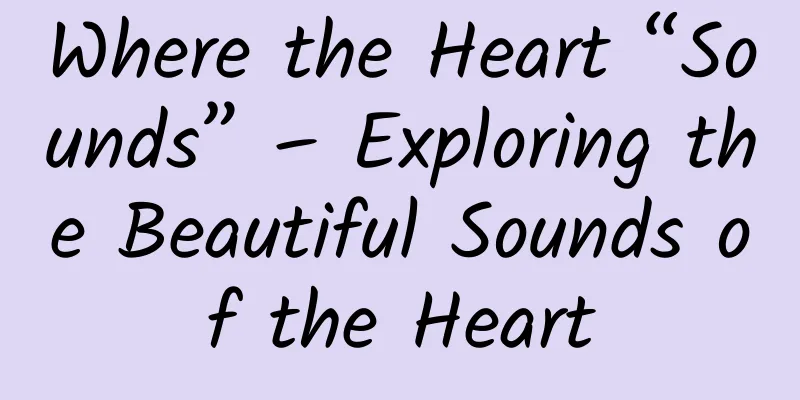Where the Heart “Sounds” – Exploring the Beautiful Sounds of the Heart

|
Author: Chen Bingwei, deputy chief physician of Tianjin First Central Hospital Reviewer: Xia Dasheng, Chief Physician, Tianjin First Central Hospital "Life" is wonderful, and there are many words to describe life. You must have heard of the "rhythm of life", in which the "rhythm" refers to the regular beating of the heart. Figure 1 Copyright image, no permission to reprint Figure 2 Copyright image, no permission to reprint The heart is the "engine" of the human body. A healthy and strong heartbeat maintains the blood circulation of the body and is the guarantee of the "vitality" of the human body. The most direct feeling of the heartbeat is its sound, which is the "heart sound" in medicine. How are heart sounds produced? We need to first understand the anatomical structure of the heart. From an anatomical point of view, the heart is like a house, a hollow structure similar to a balloon formed by cardiac tissue. This structure has two layers, the upper layer is called the atrium, and the lower layer is called the ventricle. The upper and lower layers each have two "rooms", the upper layer is the left atrium and the right atrium, and the lower layer is the left ventricle and the right ventricle. A complete house must have walls, doors and windows, electrical circuits, water pipes, etc. The "walls" of the heart are the atrial walls and ventricular walls, the "doors and windows" are the heart valves, the "electrical circuits" are the heart's conduction system, and the "water pipes" are the coronary arteries we often mention. Figure 3 Copyright image, no permission to reprint The blood in the heart's blood vessels flows unidirectionally, that is, it can only flow in one direction. To ensure unidirectional blood flow, the heart's "doors and windows" (i.e. valves) play an important role. These "doors and windows" are like "one-way valves" in a machine, which can only be opened in one direction. When the blood tries to flow in the opposite direction, the valve will close. The heart valves include the tricuspid valve that separates the right atrium and the right ventricle, the mitral valve that separates the left atrium and the left ventricle, the pulmonary valve that ensures that blood can only go out of the right ventricle but not in, and the aortic valve that ensures that blood can only go out of the left ventricle but not in. Figure 4 Copyright image, no permission to reprint Medically, heart sounds are defined as the sound produced by the contraction of the myocardium, the closing of the heart valves, and the vibrations caused by the blood hitting the walls of the ventricles and aortas. The heart sounds we usually hear are caused by the vibrations of the heart's "doors and windows", that is, the heart valves, when they close. When the human body is in an extremely tense state, it can feel its own heartbeat, and the stethoscope is the one that can really hear the sound of the heartbeat. It is also an essential examination tool for every clinician. Before the invention of the stethoscope, in order to listen to the heartbeat, the doctor could only put his ear against the patient's body, which was neither hygienic nor elegant. In the early 19th century, French doctor Laennec invented the wooden stethoscope, which was also called the "doctor's flute" because it looked like a flute. Since then, the stethoscope has been continuously improved and gradually formed the current double earpiece + rubber tube + vibration membrane. Figure 5 Copyright image, no permission to reprint When listening to heart sounds with a stethoscope, the first sound is a low and long sound, which is louder at the apex. It is formed when the mitral valve and tricuspid valve close when the ventricle contracts. The closure of these two valves can prevent the blood in the ventricle from flowing back to the atrium, ensuring that the blood can only flow to the aorta and pulmonary artery. The second heart sound is high and short, and is louder in the upper part of the heart. It is formed when the aortic valve and pulmonary valve close when the ventricle relaxes. The closure of these two valves can prevent the blood in the aorta and pulmonary artery from flowing back to the ventricle, otherwise the heart will do useless work. Figure 6 Copyrighted images are not authorized for reproduction Figure 7 Copyright image is not authorized for reproduction Diseased heart valves can cause changes in heart sounds. If the valves fail to close, "incomplete closure" will occur, leading to "regurgitation"; if the valves are restricted from opening, "stenosis" will occur, leading to blood flow obstruction. When the flowing blood passes through the abnormal opening of the valve quickly, a sound similar to blowing wind will be produced, which is the so-called "heart murmur". Figure 8 Copyright image, no permission to reprint In addition, if there is a defect in the "walls" between the heart (ventricular septum, atrial septum), abnormal blood flow will occur when blood flows through these holes, and abnormal heart sounds will also be produced. Figure 9 Copyright image, no permission to reprint By auscultating the heart, the doctor can determine the cause of the disease based on the location and nature of the heart murmur, and can subsequently perform cardiac ultrasound and other examinations to further clarify the diagnosis. Understanding heart sounds is important for us to understand the heart and prevent and treat heart diseases. In this fast-paced society, we should pay more attention to the sound of our heartbeats, cherish life, and care about health. |
>>: If you often wake up in this sleep stage, do you have the chance to become a genius?
Recommend
Technical Practice of Heterogeneous Hybrid Scheduling in vivo Internet
The shuffling layer is responsible for integratin...
Many "ghost plane" incidents are related to decompression
On the afternoon of September 4th local time, a s...
The dilemma of TikTok: Isn’t TikTok a short video? !
Short videos have always been very popular. I rem...
How to transport the long wind turbine blades up the mountain? Here comes the answer
Some time ago, a video of builders transporting 7...
Tencent Youlianghui’s strategy for achieving explosive advertising volume!
When I came to the company in the morning, the fi...
Wei Ya’s 4 core secrets of selling goods through live streaming!
Selling goods through live streaming is not that ...
A good way to prevent theft when charging AirPods? Merchants actually do this
When we put AirPods in the charging box to charge,...
The color of salt is so attractive! Unlock the secrets of China's most beautiful salt lakes
Say goodbye to the crowded popular attractions. T...
Nvidia accuses Qualcomm and Samsung of infringing its graphics processing technology patents
Chipmaker Nvidia said on Thursday it has sued riv...
Is information flow advertising ineffective? Maybe you didn’t choose the right promotion channel!
In the past, educational institutions’ promotiona...
A complete analysis of Tik Tok content operations, just read this article!
There is no need to say much about the popularity...
How to improve activity and retention? A brief analysis of the user growth system in financial apps!
The user growth system refers to modules or funct...
Breaking the cognition! A large number of migratory birds "bird flow" actually fly horizontally across the Taklimakan Desert
Produced by: Science Popularization China Author:...
How I became number one on the App Store
Happiness comes too suddenly? Others say that our...
Essential for overseas promotion: What are the global advertising channels?
AppsFlyer breaks down data by industry verticals ...









